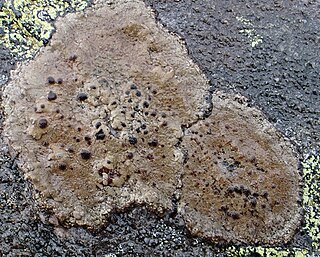
The Pertusariales are an order of fungi in the class Lecanoromycetes, comprising 8 families, 31 genera, and over 600 species, many of which form lichens. This diverse group is characterized by complex taxonomic history and ongoing phylogenetic revisions. Originally proposed by Maurice Choisy in 1949 and later formally published by the lichenologists David L. Hawksworth and Ove Eriksson in 1986, Pertusariales has undergone significant reclassification due to molecular phylogenetics studies. The order includes well-known genera such as Pertusaria and Ochrolechia, as well as families like Megasporaceae and Icmadophilaceae.

Fuscideaceae is a family of fungi that form symbiotic] relationships with algae to create lichens. These lichens typically have a crust-like appearance and are found worldwide, though they are most common in temperate regions. The family includes five genera and about 55 species, which primarily grow on tree bark, rocks, or occasionally on wood or leaves. Fuscideaceae lichens are characterised by their reproductive structures, cup-like formations called apothecia, which can vary in colour from red to dark brown or black. The family has undergone several changes in its classification over the years, with recent genetic studies placing it within the order Umbilicariales. Fuscideaceae lichens produce various chemical compounds, some of which are unique to this family, and these chemicals are often used to help identify different species.
Phlyctis psoromica is a species of corticolous (bark-dwelling) crustose lichen in the family Phlyctidaceae. Native to New South Wales, Australia, it was described as new to science in 2011. This lichen is characterised by its whitish to pale blue-grey crustose thallus and distinctive secondary chemistry.

Varicellaria is a genus of crustose lichens. It is the only genus in the family Varicellariaceae.
Teuvoa is a genus of lichen-forming fungi in the family Megasporaceae. It was first classified by lichenologists Mohammad Sohrabi and Steven Leavitt in 2013, with Teuvoa uxoris assigned as the type species. This genus was delineated from the larger genus, Aspicilia, following a molecular phylogenetic analysis which revealed that the Aspicilia uxoris species group constituted a distinct lineage in the Megasporaceae. Initially containing three species, two additional species native to China were added in 2018. Teuvoa is characterised by its small ascospores and conidia, and the absence of secondary metabolites.

Fuscidea multispora is a species of foliicolous (leaf-dwelling), crustose lichen in the family Fuscideaceae. Found in Bolivia, it is known to occur only in a single high-altitude locality in a national park, where it grows on the leaves of coniferous trees from the genus Podocarpus.
Lecidea hoganii is a rare species of saxicolous (rock-dwelling), crustose lichen in the family Lecideaceae. It is known to occur only in Boulder, Colorado, where it grows in association with other lichens in mixed saxicolous communities on sandstone in the Fox Hills Formation. The lichen is characterized by its thick white, chalky thallus, sessile to raised apothecia, presence of a dark pink pigment in the hymenium, and absence of secondary compounds.
Maronora is a monotypic fungal genus in the family Fuscideaceae. It contains the single species Maronora cyanosora, a corticolous (bark-dwelling) lichen. It is characterised by its distinctive bluish-grey circular soralia on the thallus, Lecanora-like apothecia, and simple, hyaline ascospores.

Piccolia nannaria is a species of crustose lichen in the class Lecanoromycetes. It is widespread but uncommon in the coastal plain of southeastern North America. Initially thought to be corticolous (bark-dwelling), later collection of the lichen suggest that it may be lichenicolous (lichen-dwelling).
Malmidea albomarginata is a species of corticolous (bark-dwelling), crustose lichen in the family Malmideaceae. It is found in Venezuela.
Malmidea allobakeri is a species of corticolous (bark-dwelling), crustose lichen in the family Malmideaceae. It is found in Venezuela.
Malmidea allopapillosa is a species of corticolous (bark-dwelling), crustose lichen in the family Malmideaceae. It is found in Venezuela.
Malmidea atlanticoides is a little-known species of corticolous (bark-dwelling), crustose lichen in the family Malmideaceae. It is found in Brazil.
Malmidea hernandeziana is a little-known species of corticolous (bark-dwelling), crustose lichen in the family Malmideaceae. It is found in Venezuela. The distinctive features of this species include a thallus with coralloid-like outgrowths, light-coloured fruiting bodies (ascomata) with a specialised structural layer, relatively large spores that tend to have slightly thickened walls at their ends, and the absence of specific lichen products typically found in other species of the genus. This combination of characteristics sets Malmidea hernandeziana apart from other species in the genus Malmidea.
Malmidea isidiifera is a species of corticolous (bark-dwelling), crustose lichen in the family Malmideaceae. It is found in Brazil and Venezuela.
Malmidea leucopiperis is a species of corticolous (bark-dwelling), crustose lichen in the family Malmideaceae. It is found in Brazil.
Malmidea rhodopisoides is a species of corticolous (bark-dwelling), crustose lichen in the family Malmideaceae. It is found in Brazil.
Malmidea subcinerea is a species of corticolous (bark-dwelling), crustose lichen in the family Malmideaceae. It is found in Venezuela. The lichen has a smooth, dull thallus varying in colour from grey to olive, with a white internal medulla. It has sessile, rounded apothecia with light beige to greyish-brown discs.
Malmidea volcaniana is a species of corticolous (bark-dwelling), crustose lichen in the family Malmideaceae. It is found in Venezuela. A major characteristic of the species is the coralloid (coral-shaped) clumps of isidia-like outgrowths on the thallus surface.
Meridianelia is a fungal genus in the family Elixiaceae. It consists of the single species Meridianelia maccarthyana, a corticolous (bark-dwelling), crustose lichen. This lichen forms greyish-white, crust-like growths on tree bark in subalpine woodlands of Tasmania, Australia. Discovered in 2003 and scientifically described in 2009, Meridianelia is classified in the small fungal family Elixiaceae based on its genetic and structural characteristics. The genus is notable for its unique reproductive structures and its apparent rarity, having been found in only a few locations despite growing in a relatively common type of forest.




